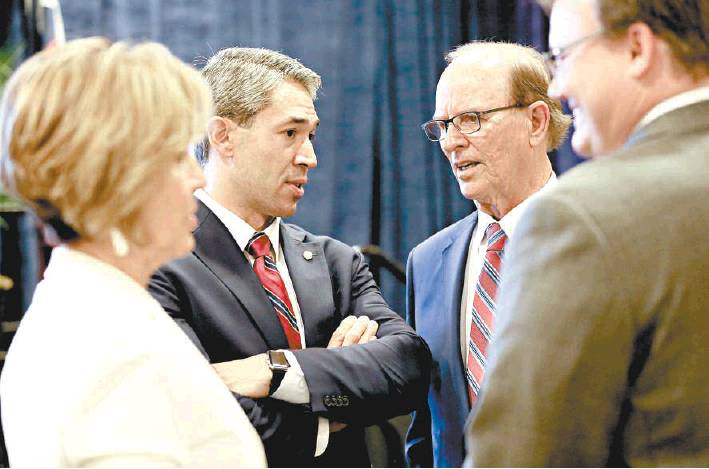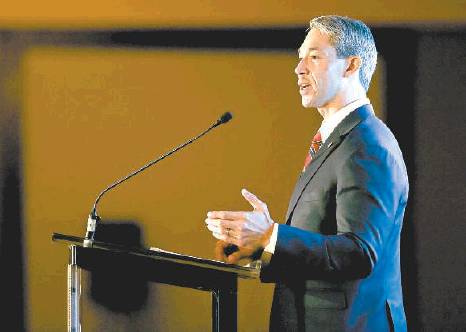Nirenberg to address housing woes
More mass transit urged to prepare for growth, too
By Josh Baugh STAFF WRITER
In a major policy speech Friday, Mayor Ron Nirenberg laid out his vision for San Antonio, unveiled a task force to address affordable housing and gentrification, and called for an expansion of mass transit while declaring that “San Antonio is open for business.”
Reading from a teleprompter and rarely deviating from the script, Nirenberg delivered the address at a luncheon for the North San Antonio Chamber of Commerce. He drove home points that would soothe business leaders worried that his progressive politics might harm their work, particularly the development industry. But he also spoke about ideas favored by his progressive supporters, such as mass transit, the new-energy economy and deterrence of gentrification.
This year, the City Council is prioritizing some spending based on equity, rather than a roughly equal division of funds across each of the 10 council districts. Historically, the South, East and West sides have received less funding for necessary infrastructure, particularly with regard to streets, sidewalks and drainage.
Through an “equity lens,” Nirenberg and the council are pushing for additional funding for those areas (and District 10 on the Northeast Side) to help increase the average quality of their roads.
Nirenberg never mentioned by name his predecessor — Ivy Taylor, whom he ousted in June — but pulled no punches as he discussed where San Antonio has been and where it’s headed.
“I have a bold vision, not just for the next eight years, but for us today and for my son’s generation tomorrow. He’s 9 now, and by the time he’s my age, the city will have doubled in population to the size of Chicago. What we do now matters, from transportation and protecting our natural resources to fostering great schools and growing jobs,” he said.
“My vision today is shaped by Jonah’s future. And it’s a shared vision, guided by community conversations that started years ago with SA2020. It aligns with our own ambitious blueprint for our future, SA Tomorrow,” he said. “And while we’ve grappled recently with some doldrums, with sliding back to business as usual, we’re starting to reclaim our momentum.”
Nirenberg, who calls former Mayor Phil Hardberger a mentor and who first served on the council under then-Mayor Julián Castro, saw the momentum those mayors had created come to a halt under Taylor, he said — one of the reasons he decided to run against her.
Looking to the future, Nirenberg said the status quo won’t prepare San Antonio, noting 150 vehicles added to the roads here every day. The infrastructure investments voters approved in this year’s bond election will barely keep up with the pace of growth, and in the ensuing decades, commute times are expected to increase by 75 percent.
The mayor laid out an argument for making a major investment in a modern transit system.
“If we don’t plan for transit now, we will cripple our economy and erode the quality of life that makes San Antonio so great,” he said. “We won’t blame ourselves, but our children will.”
The transit system he envisions is one that connects communities and employment hubs and that supports sustainable development — but it’s not one that is solely based on rail. It includes better bus service, as well. The city’s fiscal year 2018 budget begins to bolster funding for VIA Metropolitan Transit to increase frequency on several of its key routes.
But rail is also a key element for a modern transit system, Nirenberg said, and one that “must be citizen-driven and voter-approved.”
Nirenberg has repeatedly said he wants to target good-paying jobs for San Antonio, and part of that, he said, is strengthening the local workforce through workforce development programs and education. Beyond that, San Antonio will “continue to foster innovation, entrepreneurship and startups,” ensuring the city is competitive regionally and internationally. Nirenberg said he’ll work to reduce municipal red tape and amplify the work of business incubators.
The city is aggressively pursuing expansion of the local Toyota manufacturing plant, he said, declaring that the city is open for business.
And while San Antonio’s economy is outperforming Texas and the U.S., “we can’t afford to get complacent,” he said.
“We will grow our biomedical research and manufacturing industries by targeting new companies, and we’ll work to restore momentum in venture capital investments within our growing technology and biotech community,” he said. “Working responsibly with our available natural resources, existing businesses and a municipally served consumer market, there is no reason why we cannot become a national leader in the green economy.
“Environmentalism is good for business, too.”
Nirenberg announced that he’s formed a task force charged with developing a comprehensive housing policy for San Antonio, one that will address the lack of affordable housing and gentrification issues here.
The Mayor’s Housing Policy Task Force will be led by Lourdes Castro-Ramirez, the former CEO of the San Antonio Housing Authority who went on to become the principal deputy assistant secretary of the U.S. Housing and Urban Development Department under then-Secretary Julián Castro.
The task force also includes former Councilwoman María Antonietta Berriozábal, Pape-Dawson Engineering owner Gene Dawson, banker Noah Garcia and architect Jim Bailey.
San Antonio is facing a major housing crisis, Nirenberg said, one that can no longer be ignored. In the ensuing two decades, the city will need more than 500,000 new multifamily and single-family residences to accommodate the expected surge in population. A city-funded analysis shows that there’s currently a need for 142,000 affordable housing units, and census data show nearly 20 percent of San Antonians are living in poverty, he said.
The task force will develop policy recommendations, working in concert with city and nonprofit staffers. With technical working groups, the task force also will work on topics such as neighborhood stability and gentrification, incentives for development of affordable housing in high-growth areas, bolstering regulations designed to ensure long-term quality in housing construction, and easing of regulations that currently hinder the development of affordable housing.
Nirenberg pushed back against comments that Councilman Greg Brockhouse has made recently deriding the city’s plan to budget through a focus on equity. A staunch opponent of the concept, Brockhouse has said it amounts to nothing more than a cool hashtag. The proposed fiscal 2018 budget, a $2.7 billion record-breaking behemoth, attempts to address historically underfunded areas.
Nirenberg, who applauded City Manager Sheryl Sculley for her work on the budget (and described her, as Hard-berger and Castro often did, as the greatest city manager in the U.S.), said the concept is much more.
“ ‘Equity’ is not a catchphrase or a slogan. It’s a process and a value, fiscally responsible and rooted in compassion,” he said. “If a budget is a moral document, then this one is our most honest. It has required us to confront past mistakes — choices that have made us one of the most economically segregated cities in the country — and restore equity for all of our residents.”
JBaugh@express-news.net Twitter: @jbaugh

